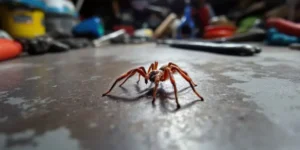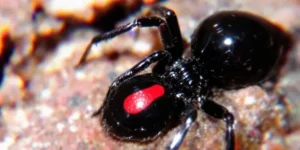Have you ever noticed a tiny spider with a bright red back? That’s the redback jumping spider! These small spiders inhabit many areas of western North America. They’re known for their vibrant colours and jumping abilities.
Let’s explore more about these fascinating little creatures.
Key Takeaways
- Redback jumping spiders are small but eye-catching, with bright red backs and great jumping skills.
- They live in dry areas of North America, from the US to Canada and Mexico, and like coastal dunes and oak woods.
- These spiders eat insects half their size and can jump up to 50 times their body length.
- Their venom is mild and rarely harms humans, causing only a small pinch like a bee sting.
- People often mix them up with other red bugs, but they’re different from redback spiders, which are more dangerous.

Description of Phidippus Johnsoni

Phidippus johnsoni, also known as the redback jumping spider, is a small but striking arachnid. Adult females measure 9.0-14.2 mm long, while males are smaller at 6.2-10.7 mm. Both sexes sport a bright red abdomen, but females have a black stripe down the middle.
Males stand out with their all-red abdomen and larger pedipalps. These spiders are part of the Salticidae family, recognised for their keen eyesight and jumping abilities.
These colourful jumpers are easily noticeable in their natural environment. Their red backs act as a warning to predators. Despite their small size, about 1 cm long, they’re confident hunters.
They use their sharp vision to track prey before leaping to catch it. Their nimble movements and bright colours make them popular among spider enthusiasts and photographers.
Natural Habitat and Distribution
Redback jumping spiders inhabit arid regions throughout North America. They are present in the Western United States, Baja California, and sections of Canada and Mexico. These spiders prefer coastal dunes and oak woodlands.
They flourish from sea level to the tree line.
Research from 1976 identified 2 to 30 spiders per 1,000 square metres. Spring is the peak season for observing these small jumpers. They are active and occupied during this period.
Their extensive distribution demonstrates their adaptability to various environments. The next section examines the behaviour of these spiders in their habitats.
Behavioural Habits and Characteristics
Redback jumping spiders construct tubular silk nests beneath rocks and wood. They also establish homes on grape vines. These spiders consume insects approximately half their size. Their diet includes flies, bugs, moths, and even other spiders.
Female redbacks can be quite aggressive. They may consume male spiders after mating. This spider resembles velvet ants, which have painful stings. This resemblance helps deter predators.
These spiders have some distinctive behaviours. They hunt by leaping on their prey. Their keen eyes assist them in spotting food from a distance. Redbacks can jump up to 50 times their body length.
This is comparable to a human leaping over a football field. They use silk lines as safety measures when they jump. This aids them in landing safely if they miss their target. The following section examines the venom and bite effects of these intriguing creatures.
Venom and Bite Effects
Redback jumping spiders have a mild venom. Their bites rarely cause harm to humans. Most people experience a small pinch, similar to a bee sting. The bite area may become red and slightly swollen.
These effects typically resolve on their own within a day or two. Unlike some spiders, redback jumpers don’t actively seek to bite humans. They only bite if they feel extremely threatened.
It’s prudent to exercise caution when handling these spiders. While not dangerous, their bites can still be painful. Females tend to form stronger connections with humans over time.
This reduces the likelihood of them biting their owners. To establish a rapport, you can offer small mealworms in your hand. This helps the spider associate you with positive experiences, rather than perceiving you as a threat.
Always maintain the spider’s habitat at low humidity. They require minimal misting for hydration.
Supplementary Insights
There’s additional information to discover about the Redback Jumping Spider. We’ll examine some supplementary facts and clarify common misconceptions.
Comparison of Phidippus Johnsoni and Redback Spider
The Phidippus johnsoni and redback spider are often confused. Here are their key differences.
| Feature | Phidippus johnsoni | Redback Spider |
|---|---|---|
| Scientific Name | Phidippus johnsoni | Latrodectus hasselti |
| Common Name | Johnson’s Jumping Spider | Redback Spider |
| Size | 6-13 mm | 3-10 mm |
| Colour | Black with red back | Black with red stripe |
| Web | No web | Messy web |
| Venom | Mild, not harmful to humans | Potent, can be harmful to humans |
| Movement | Jumps | Crawls |
These spiders look alike but act very different. The Johnson’s jumping spider is active and jumps. The redback spider is shy and hides in its web. Jumping spiders have big eyes for hunting. Redbacks have small eyes and rely on their web to catch prey. The redback’s venom can hurt humans, while the jumping spider’s can’t. Knowing the difference is important for safety. If you’re unsure, consult an expert or check RedBackSpider.com for more information.
Common Misidentifications
Moving from comparing Phidippus Johnsoni and redback spiders, we now examine common misidentifications. People often confuse these spiders with other insects, which can result in unnecessary concern or incorrect decisions.
- Velvet ants: Many individuals mistake Phidippus Johnsoni for velvet ants. These ants, from the Dasymutilla group, share bright colours with the spider. However, velvet ants can deliver painful stings, while the spider cannot.
- Redback spiders: Some confuse Phidippus Johnsoni with the dangerous redback spider. This misidentification is risky as redbacks are highly venomous. Redbacks have a red stripe on their back, while Phidippus Johnsoni is red all over.
- Jumping spiders: Other jumping spider species can resemble Phidippus Johnsoni. They all jump and have large eyes. However, Phidippus Johnsoni has its distinctive red and black appearance.
- Ladybirds: From a distance, the bright red of Phidippus Johnsoni may appear similar to a ladybird. However, upon closer inspection, one can observe the spider’s furry body and eight legs.
- Red mites: Tiny red mites may resemble baby Phidippus Johnsoni. However, mites are significantly smaller and do not jump like these spiders.
- Ticks: Some individuals mistake the round body of Phidippus Johnsoni for a tick. Ticks are flat until they feed, whereas these spiders maintain a plump appearance.
- Red beetles: Certain red beetles may initially appear similar to Phidippus Johnsoni. However, beetles possess hard wing covers, unlike the soft body of the spider.
How to Care for a Johnson’s Jumping Spider
Caring for a Johnson’s jumping spider can be an enjoyable and fulfilling experience. Here’s a straightforward guide to assist you in keeping your eight-legged companion content and well:
- Feed adult spiders once or twice a week. Offer small crickets, dubia roaches, fly larvae, or tiny mealworms.
- Give spiderlings fruit flies more often. They need to eat more frequently than adults.
- Provide fresh water weekly. Use small water droplets or a damp paper towel for spiderlings.
- House your spider in an enclosure at least 4x4x8.5 inches. This provides them ample space to jump and explore.
- Use coco-fibre or sand-based soil as substrate. This replicates their natural habitat.
- Add cork bark and fake plants to the enclosure. These items allow your spider to climb and build webs.
- Maintain appropriate humidity levels. Mist the enclosure lightly once a week.
- Clean the enclosure regularly. Remove uneaten food and waste to prevent mould.
- Handle your spider gently and sparingly. They’re fragile and can become stressed by excessive handling.
- Monitor for signs of illness or stress. Observe any changes in eating habits or unusual behaviour.
- Offer environmental enrichment. Alter the layout of the enclosure periodically to keep your spider engaged.
- Avoid sudden temperature changes. Keep the enclosure away from drafts or direct sunlight.
Phidippus Johnsoni: The Red Jumping Spider and Why It’s Worth Exploring
Phidippus johnsoni, a striking red jumping spider, fascinates enthusiasts at RedBackSpider.com for its unique colours and dynamic behaviours. This article is worth reading because it reveals how this arachnid, sometimes related to the red-backed jumping spider, thrives in nature and intrigues researchers worldwide.
1. Which Species Dominate?
As one of the species of jumping spiders, Phidippus johnsoni belongs to a larger genus. Species of jumping spiders commonly occur around the world, each with a variety of features.
2. How Do They Feed?
They usually hunt on the ground, using keen vision to track prey directly. This spider may also occur near wood on the ground, capturing insects.
3. Where in the World Are They Found?
They occur in diverse habitats and are commonly known to occupy a variety of climates. Adults tend to build silken retreats under rocks.
4. Why Does Nature Matter?
In nature, red-backed jumping spider research reveals cannibalism may probably happen among them. Mimics of mutillid wasps show how spiders adapt.
5. Does Color Define Them?
A distinct black central stripe and shining teal color can appear on the abdomen. Some show a slender frame with bright teal chelicerae.
6. Any Variation in Size?
They range from 2 to 15 millimeter in body length. Males are smaller than females by about a centimeter in length difference.
7. Are They Risky?
Although they possess a very painful fang, the risk of serious medical complications is low. Still, caution is wise.
8. How Does a Spider’s Nest Develop?
This species constructs conspicuous tubular silken homes. They constructs conspicuous tubular silken nests under bark or in sheltered spots.
9. Any Available Comparisons?
Several data points are available about wasps in the genus dasymutilla, which also possess a very painful sting.
10. What Is the Basic Nature of This Genus?
Spiders of this genus are known for bright hues. They are commonly found in nature, emphasising how they remain an essential part of our ecosystem.
Comparison Table: Red-Backed Jumping Spider Traits
| Trait | Measurement/Note |
|---|---|
| Size | Range from 2 to 15 mm |
| Color Variations | Shining teal color, red |
| Nest Construction | Tubular silken nests |
| Behaviour | Cannibalism possible |
Key Points:
- Phidippus johnsoni is a red jumping spider with a variety of colors
- They commonly build silken retreats and molt to grow
- A centimeter in length difference often exists between genders
- Nests under rocks and wood are typical shelters
- Always appreciate their role in nature without disturbing them
Conclusion
The Redback Jumping Spider is a remarkable creature. Its vibrant red body and leaping abilities make it distinctive. These spiders are essential in controlling insect populations. They’re visually striking and fascinating to observe.
For spider enthusiasts, the Phidippus johnsoni is an excellent subject for research or as a companion.
For a closer look at these fascinating creatures, explore our gallery of Redback Spider pictures.
FAQs
1. What’s special about the Redback Jumping Spider?
The Redback Jumper, or Phidippus johnsoni, is a bright little arachnid. It’s known for its red back and jumping skills. These spiders are quick, smart, and great hunters.
2. Where can you find these spiders in Australia?
These colourful jumpers live all over Oz. You’ll spot them in gardens, parks, and bushland. They like sunny spots and often hang out on leaves or bark.
3. Are Redback Jumping Spiders dangerous to humans?
No worries, mate! These little fellas aren’t a threat. They might nip if you bother them, but it’s not harmful. They’re more scared of you than you are of them.
4. How do these spiders catch their tucker?
Redback Jumpers are clever hunters. They use their keen eyesight to spot prey, then pounce with amazing accuracy. They don’t spin webs but use silk lines as safety ropes when jumping.





